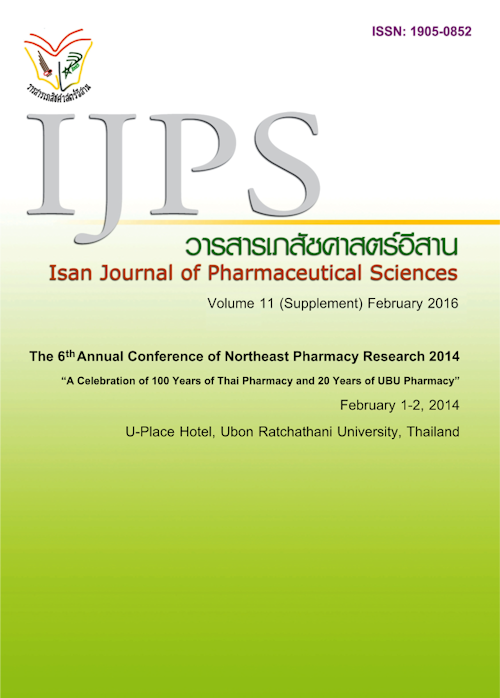Development of Triphala Niosomes
Main Article Content
Abstract
Introduction: Triphala is formulation of three dried fruits of Terminalia chebula, Terminalia bellirica, and Phyllathus emblica in equal proportions. This formulation is the most popular Ayurvedic medicines. In present study, we want to developed niosomes formulation for loaded Triphala because plant extracts had less amount, the good delivery system for deliver plant extract to target action, increase therapeutic and decrease toxicity. Materials and Method: 95% Ethyl alcohol extraction of Triphala, filtrated , filtered through 0.22 mm, get rid of 95% ethanol with rotary evaporator. Developed niosomes formulation for Triphala, determined size, PDI, zeta potential and %entrapment efficiency (%EE) Results: Factors for developed niosome’s formulation for loaded Triphala component span20, total lipid 50 mM, cholesterol 15% and plant extract 0.1%, this formula had size 164.89± 0.47 mm and %entrapment efficiency 47.65± 1.56, zeta potential more than 30 mV, PDI less than 1. Optimize formulation with Response Surface Methodology (RSM) had component total lipid 50 mM, cholesterol 10% and plant extract 0.1% had size 188.10±16.34 nm and %entrapment efficiency 46.43±4.20 % Conclusion : Optimize of formulation niosomes for loaded Triphala component total lipid, cholesterol and plant extract had size and maximum %entrapment efficiency and Triphala niosomes should storage at room temperature.
Article Details
In the case that some parts are used by others The author must Confirm that obtaining permission to use some of the original authors. And must attach evidence That the permission has been included
References
Jagetia G, Baliga S, Malagi K, et al. The evaluation of the radioprotective effect of Triphala (an ayurvedic rejuvenating drug) in the mice exposed to γ-radiation. Phytomedicine. 2002; 9, 99–108.
Kumar T, Rungseevijitprapa W, Chaiyarut C, et al. Screening of steroid 5α-reductase inhibitory activity and total phenolic content of Thai plants. Journal of Medicinal Plants Research. 2011. 5(7), pp. 1265-1271
Kumar T, Rungseevijitprapa W, Chaiyarut C, et al. 5α- reductase inhibition and hair growth promotion of some Thai plants traditionally used for hair treatment. Journal of Ethnopharmacology. 2012;139, 765–771
Mukherjee P, Rai, Sujay, et al. Clinical study of Triphala-A wellknown phytomedicine from India. Iranian J. Pharmacol. Ther. 2006; 5, 51–54.
Sandhyaa T, Lathikaa, K, Pandeyb, et al. Potential of traditional ayurvedic formulation, Triphala, as a novel anticancer drug. Cancer Lett. 2006; 231 (2), 206–214.


